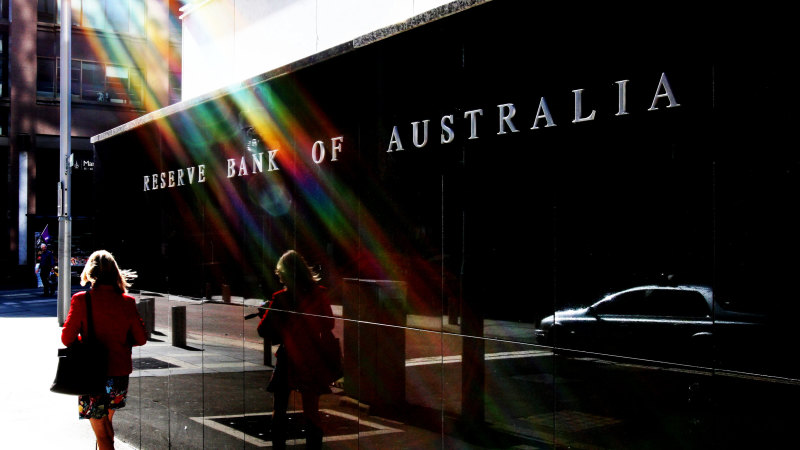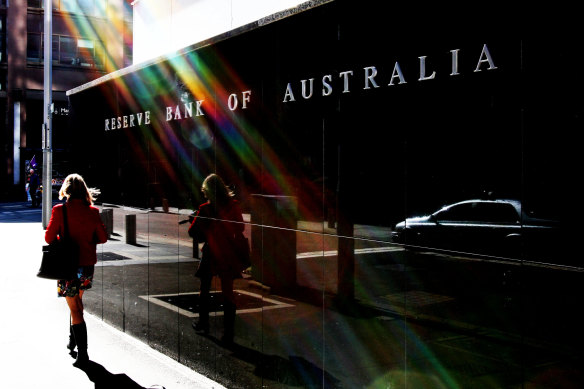Why are economists’ forecasts so often wrong, and why do they so often fail to see the freight train heading our way? Short answer: because economists don’t know as much about how the economy works as they like to think they do – and as they like us to think they do.
What happens next in the economy is hard to predict because the economy is a beehive of humans running around doing different things for different reasons, and it’s hard to predict which way they’ll run.
The Reserve Bank is far more prone to admitting the fallibility of its modelling exercises than most modellers.Credit:Peter Braig
It’s true we’re subject to herd behaviour, but it’s devilishly hard to predict when the herd will turn. Humans are also prone to fads and fashions and joining bandwagons – a truth straightlaced economists prefer to assume away.
I think it embarrasses economists that their discipline’s a social science, not a hard science. Their basic model of how the economy works became entrenched long before other social sciences – notably, psychology – had got very far.
They dealt with the human problem by assuming it away. Let’s assume everyone always acts in a rational, calculating way to advance their self-interest. Problem solved. And then you wonder why your predictions of what “economic agents” will do next are so often astray.
Actually, the economists don’t wonder why they’re so often wrong – we do. They prefer not to think about it. Anyway, there’s this month’s round of forecasts we need to get on with.
The economists’ great mission over the past 80 years has been to make economics more “rigorous” – more like physics – by expressing economic relationships in equations rather than diagrams or words.
These days, you don’t get far in economics unless you’re good at maths. And the better you are at it, the further up the tree you get. The academic profession is dominated by those best at maths.
Trouble is, although using maths can ensure that every conclusion you draw from your assumptions is rigorously logical, you’ll still get wrong answers if your assumptions are unrealistic.
In the latest issue of the International Monetary Fund’s magazine, the ripping read named Finance and Development, a former governor of the Bank of Japan reminds his peers about the embarrassing time in 2008, after the global financial crisis had turned into the great recession, when Queen Elizabeth, visiting the London School of Economics, asked the wise ones why none of them had seen it coming.
With frankness uncharacteristic of the Japanese, the former governor observed that King Charles could go back and ask the same question: why did no one foresee that the economic managers’ response to the pandemic would lead to our worst inflation outbreak in decades?
One answer would be: because all our efforts to use computerised mathematical modelling to make our discipline more rigorous has done little to make us wiser. The paradox of econometric modelling is that, though only the very smart can do it, the economy they model is childishly primitive, like a stick-figure drawing.
The best response some the world’s economists came up with, long after the Queen had gone back to her palace, was that academic economists had largely stopped teaching economic history.
These days, economists can’t do anything much without sets of “data” to run through their models. And before computerisation, there were precious few data sets. But those who forget history are condemned to . . .
The great temptation economists face is the one faced by every occupation: to believe your own bulldust. To be so impressed by the wonderful model you’ve built, and so familiar with the conclusions it leads you to, you forget all its limitations – all the debatable assumptions it’s built on, and all the excluded variables it isn’t.
As part of the academic economists’ campaign for an inquiry into the Reserve Bank, some genius estimated that the Reserve’s reluctance to cut its already exceptionally low official interest rate even lower in the years before the pandemic had caused employment to be 250,000 less than it could have been.
Only someone mesmerised by their model could believe something so implausible. Someone who, now they’ve got a model, can happily turn off their overtaxed brain. There’s no simple linear, immutable relationship between the level of interest rates and the strength of economic growth and the demand for labour.
At the time, it was obvious to anyone turning their head away from the screen to look out the window that, with households already loaded with debt, cutting rates a little lower wouldn’t induce them to rush out and load up with more – the exception being first-home buyers with access to the Bank of Mum and Dad, who as yet only aspired to be loaded up.
To be fair to the Reserve in this open season for criticism, it’s far more prone to admitting the fallibility of its modelling exercises than most modellers are – especially those “independent consultants” selling their services to vested interests trying to pressure the government.
In its latest statement on monetary policy, the Reserve explains how its modelling finds that supply side factors explain about half the rise in the consumer price index over the year to September 2022.
But then it used a more sophisticated “dynamic stochastic general equilibrium model” which found that supply factors accounted for about three-quarters of the pick-up in inflation.
The Reserve’s assistant governor (economic), Dr Luci Ellis, told a parliamentary committee last month that this “triangulation” left her very confident that the demand side accounted for at least a quarter and probably up to a third of the inflation we’ve seen.
(Remembering the debate about the extent to which the present inflation surge reflects businesses sneaking up their profit margins – their “mark-ups,” in econospeak – note that this second model includes “mark-up” as part of the supply side’s three-quarters. Always pays to read the footnotes.)
One of the tricks to economics is that many of the economic concepts central to the way economists think are “unobserved” – the official statisticians can’t measure them directly. So you need to produce a model to estimate their size.
A case in point is the economists’ supposed measure of full employment, the NAIRU – non-accelerating-inflation rate of unemployment – the lowest the rate of unemployment can fall to before this causes wage and price inflation to take off.
Some of those business economists who believe the Reserve hasn’t raised interest rates nearly enough to get inflation down justify this judgement by saying our present unemployment rate of 3.7 per cent is way, way below what conventional modelling tells us the NAIRU is: about 5 per cent.
But Ellis told the parliamentary committee that the Reserve had rejected this estimate. The “staff view” was that the NAIRU had moved from “the high threes to the low fours”, and this was what its forecasts were based on.
So why dismiss the conventional model? Because, Ellis explained, it’s driven solely by demand-side factors. It’s “not designed to handle the supply shocks that we have seen over COVID”.
Oh. Really. Didn’t think of that. Mustn’t have had my brain turned on.
Ross Gittins unpacks the economy in an exclusive subscriber-only newsletter every Tuesday evening. Sign up to receive it here.
Most Viewed in Business
From our partners
Source: Read Full Article

